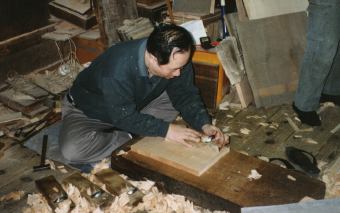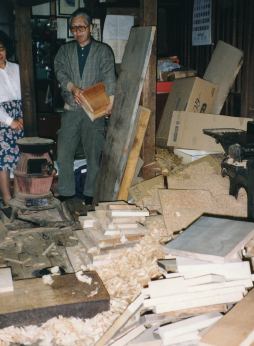Visit to ... Shimano-san, the blockmaker
Mr. Shintaro Shimano
One bright spring day this year, my wife and I took some time out from our own work to visit the man who supplies me with the cherry blocks necessary for my printmaking, Mr. Shintaro Shimano. He is a very busy person, but graciously allowed me to steal some of his time to ask a few questions and watch him working.
Stepping into his workshop is like stepping into another world. Curly shavings and off-cuts of cherry wood reach waist high in mounds around the small room. A couple of months ago, in the coldest part of the year, the room would have been filled with the fragrance of burning cherry, for what other heating fuel would possibly be needed by someone who spends his days creating these mountains of wood chips? The old cast iron stove is cold now, and the door is thrown open to the spring air. Only a tiny space in the center of the room is clear of debris, and here lies his 'atedai', the massive slab of thick cherry upon which are placed the blocks to be planed smooth. He sits cross legged on a thin cushion before this altar, and with repeated passes of his finely honed planes, gradually peels away the unwanted roughness, to leave a finished surface smoother than one could possibly imagine. No electric planer yet made can do such an accurate job on this obstinate wood, nor can any sandpaper leave the required 'hard' surface.
 As he progresses through the sequence of five
different planes used on each board, the shavings become gradually
thinner and thinner. I pick up some of these to inspect them, and
find that they are almost transparent in their thinness. I can
actually read a newspaper through one.
As he progresses through the sequence of five
different planes used on each board, the shavings become gradually
thinner and thinner. I pick up some of these to inspect them, and
find that they are almost transparent in their thinness. I can
actually read a newspaper through one.
Mr. Shimano, now 53 years of age, is one of only two men in the world still doing this job. As the only other worker is an older man in his 80's, it seems that Mr. Shimano will at some point in the future become the last of the breed. He is indeed a member of an 'endangered species', ukiyo-e printmakers, a group of men stranded in a time warp, practicing a craft that logic would dictate should have died a century or so ago, when mechanical printing arrived in Japan. Why does he still do it?
 Shimano-san came to this work by following in his
father's foot-steps. He is the third generation of his family to work
these planes, in this room, and presumes that he will be the last.
For him, there is no question of stopping. It is his job, and he
takes pride in doing it as well as he can. There is also the question
of responsibility to the craft. Upwards of 50 or 60 people, carvers,
printers and publishers, are totally dependent on his blocks to do
their jobs. If he decided to discontinue production, they (and I!)
would be thrown out of work, and ukiyo-e would take its final bow,
some 300-odd years after its birth.
Shimano-san came to this work by following in his
father's foot-steps. He is the third generation of his family to work
these planes, in this room, and presumes that he will be the last.
For him, there is no question of stopping. It is his job, and he
takes pride in doing it as well as he can. There is also the question
of responsibility to the craft. Upwards of 50 or 60 people, carvers,
printers and publishers, are totally dependent on his blocks to do
their jobs. If he decided to discontinue production, they (and I!)
would be thrown out of work, and ukiyo-e would take its final bow,
some 300-odd years after its birth.
He receives no acclaim for his work, no 'National Living Treasure' designation. Day after day he labours on, endlessly stroking these hard blocks with his planes, in his tiny shop planted firmly right in the very area where ukiyo-e once thrived (Hokusai's grave is just around the corner, and Shunsho's is a short walk away). His friend and neighbour, Ishii-san the carver, drops by for a chat. A print publisher calls to discuss an order of blocks. On the street he meets his old school mate Kaneko-san, the bamboo skin supplier. They all wish him good health, and so do I, and so should you. Without his dedication, we lose everything. Shimano-san, thank you very much.

